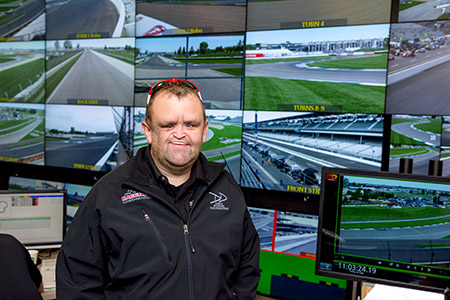Alumnus David Dusick is Transforming the Motorsports Experience

Action Tracking: David Dusick, a 1999 mechanical engineering alumnus, keeps track of all the action on the Indianapolis Motor Speedway each May for his company, RaceTrack Engineering.
While the indisputable center of the racing universe each May is the Indianapolis Motor Speedway, home of the Indianapolis 500 (proclaimed “The Greatest Spectacle in Racing”), David Dusick is quick to point out that the two-and-a-half-mile oval isn’t the only spectacle in motorsports.
In fact, there are many racetracks across the country, from large super speedways to small-town dirt tracks. And their fiercely loyal fans deserve an exhilarating experience mirroring the one in Speedway, Indiana. Increasingly, those experiences require sophisticated technology.
That’s where Dusick and RaceTrack Engineering come in.
After learning the trade as a member of IMS’s facilities engineering team, the 1999 mechanical engineering alumnus launched the Speedway-based company in 2006. The firm does plenty of high-end work at IMS racing events, and that has opened doors to bringing more sophisticated technology to smaller race tracks.
“When I first started my business, I wanted to take the things we learned at the big track and filter that down to others,” Dusick explains.
RaceTrack Engineering designs and installs timing and scoring systems, video replay systems to assist with officiating, scoreboard and video display systems, audio systems, and radio communication systems. The company also provides staffing—race directors, track marshals, timing/scoring staff and track announcers.
All of this technology benefits track operators and fans alike, and it helps raise the bar on the fan experience. Consider the timing technology. For track owners, a manual function involving people clicking stopwatches is now fully automated to insure accuracy. This lap-by-lap electronic timing data for each car is keeping fans informed through smartphones.
“We have the ability to take something that was an operational function and give it back to the fans,” Dusick says.
A similar technology transfer is likely as Global Positioning System tracking becomes more prevalent, creating a more high-end fan experience through data and video that’s available through a variety of electronic devices. In fact, video officiating is an area where race track officials are battling to keep up with the technology in spectators’ hands. Anyone watching a race can record just about anything that occurs during an event, creating videos that show such details as rule violations and spectacular crashes.
“We have to stay ahead of that curve,” says Dusick, who organized his first racing event, a mountain bike challenge, for his Rose-Hulman fraternity.
Race officials “need to have as much information as possible. If someone has more information than you do, you’re forced to make a less-informed decision,” he adds. That’s why the IndyCar race series, featuring racers from the Indianapolis 500, dropped a million bucks on a sophisticated video replay system. “They can view video footage to instantly review what happened anywhere on the track,” he says.
RaceTrack Engineering, in turn, tries to bring a similar level of sophistication to smaller race tracks. “We were tasked with finding as quality a system as we could without the million-dollar price tag,” he says. “We do that on a turnkey basis. Then, we manage the system for them.”
The same concept applies to audio systems. A great fan experience requires high-quality public-address audio that allows information to be heard over the roar of the race car engines.
“We offer a PA system lease to racetracks. We set it up and install it,” Dusick says. What was a massive and unaffordable capital expense becomes a more palatable lease payment in the operational budget, he explains.
When it comes to technological applications to enhance the fan experience, the sky is the limit. “As with any engineering project, budget is the number one constraint,” says Dusick. That’s particularly true at the smaller tracks that are vitally important to the sport, because they provide hundreds of thousands of people with weekly entertainment, feeding racing’s future with new driving talent. “To me, those smaller race track are just as important as the Indy 500,” he says.
Providing these racing services has had Dusick on the road most weekends from the early spring to late fall. His calendar for the first two months of this year’s racing season was filled with trips to help with races in St. Petersburg, Fla.; Palm Springs, Calif.; Phoenix; Memphis; Bristol, Tenn.; and Birmingham, Ala. It’s a relief that the month of May was spent in his backyard at IMS.
“The days of people sitting in wooden grandstands for hours with World War II era paging horns as their only source of race information are gone,” Dusick says.
“Today’s race fans have a different mindset, and we’re challenged to meet those expectations.”